Multi-Azimuth Ground Penetrating Radar Surveys to Improve the Imaging of Complex Fractures
Abstract
:1. Introduction
2. Materials and Methods
3. Results and Discussion
- Experimental minima approximately located at 105 degrees and 180 degrees: In agreement with the theoretical graph (Figure 10a), in which the angular distance between the lowest values was approximately 80 degrees.
- The fracture reached its highest value roughly at 45 degrees and 135 degrees, corresponding to an average angular deviation of 50 degrees from the two local minima.
- Maximum response separation of approximately 45 degrees, in partial agreement with the simulated trend (difference of 30 degrees).
- Noticeable reduction of the signature between these two points.
- The fracture was completely missed in the first and last frames, corresponding to an angular difference from the maximum values of approximately 80 degrees.
4. Conclusions
Author Contributions
Funding
Acknowledgments
Conflicts of Interest
References
- Everett, M.E. Near-Surface Applied Geophysics; Cambridge University Press: Cambridge, UK, 2011. [Google Scholar] [CrossRef]
- Daniels, D.J. Ground Penetrating Radar, 2nd ed.; The Institution of Electrical Engineers: London, UK, 2004; Volume 1. [Google Scholar]
- Wai-Lok Lai, W.; Dérobert, X.; Annan, P. A review of Ground Penetrating Radar application in civil engineering: A 30-year journey from Locating and Testing to Imaging and Diagnosis. NDT E Int. 2018. [Google Scholar] [CrossRef]
- Zhao, W.; Forte, E.; Fontana, F.; Pipan, M.; Tian, G. GPR imaging and characterization of ancient Roman ruins in the Aquileia Archaeological Park, NE Italy. Measurement 2018. [Google Scholar] [CrossRef]
- Magalhães, A.J.C.; Lima-Filho, F.P.; Guadagnin, F.; Silva, V.A.; Teixeira, W.L.E.; Souza, A.M.; Raja Gabaglia, G.P.; Catuneanu, O. Ground penetrating radar for facies architecture and high-resolution stratigraphy: Examples from the Mesoproterozoic in the Chapada Diamantina Basin, Brazil. Mar. Pet. Geol. 2017. [Google Scholar] [CrossRef]
- Lombardi, F.; Griffiths, H.D.; Wright, L.; Balleri, A. Dependence of landmine radar signature on aspect angle. IET Radar Sonar Navig. 2017. [Google Scholar] [CrossRef]
- Crosta, G.B.; Agliardi, F.; Rivolta, C.; Alberti, S.; Dei Cas, L. Long-term evolution and early warning strategies for complex rockslides by real-time monitoring. Landslides 2017. [Google Scholar] [CrossRef]
- Crosta, G.B.; Dal Negro, P.; Frattini, P. Soil slips and debris flows on terraced slopes. Nat. Hazards Earth Syst. Sci. 2003. [Google Scholar] [CrossRef]
- Baek, S.H.; Kim, S.S.; Kwon, J.S.; Um, E.S. Ground penetrating radar for fracture mapping in underground hazardous waste disposal sites: A case study from an underground research tunnel, South Korea. J. Appl. Geophys. 2017. [Google Scholar] [CrossRef]
- Zanzi, L.; Hojat, A.; Ranjbar, H.; Karimi-Nasab, S.; Azadi, A.; Arosio, D. GPR measurements to detect major discontinuities at Cheshmeh-Shirdoosh limestone quarry, Iran. Bull. Eng. Geol. Environ. 2017. [Google Scholar] [CrossRef]
- Arosio, D. Rock fracture characterization with GPR by means of deterministic deconvolution. J. Appl. Geophys. 2016. [Google Scholar] [CrossRef]
- Dorn, C.; Linde, N.; Doetsch, J.; Le Borgne, T.; Bour, O. Fracture imaging within a granitic rock aquifer using multiple-offset single-hole and cross-hole GPR reflection data. J. Appl. Geophys. 2012. [Google Scholar] [CrossRef]
- Grasmueck, M.; Quintà, M.C.; Pomar, K.; Eberli, G.P. Diffraction imaging of sub-vertical fractures and karst with full-resolution 3D Ground-Penetrating Radar. Geophys. Prospect. 2013. [Google Scholar] [CrossRef]
- Mcclymont, A.F.; Green, A.G.; Streich, R.; Horstmeyer, H.; Tronicke, J.; Nobes, D.C.; Pettinga, J.; Campbell, J.; Langridge, R. Visualization of active faults using geometric attributes of 3D GPR data: An example from the Alpine Fault Zone, New Zealand. Geophysics 2008. [Google Scholar] [CrossRef]
- Zhao, W.; Forte, E.; Fontolan, G.; Pipan, M. Advanced GPR imaging of sedimentary features: Integrated attribute analysis applied to sand dunes. Geophys. J. Int. 2018. [Google Scholar] [CrossRef]
- Pipan, M.; Forte, E.; Dal Moro, G.; Sugan, M.; Finetti, I. Multifold ground-penetrating radar and resistivity to study the stratigraphy of shallow unconsolidated sediments. Lead Edge 2016. [Google Scholar] [CrossRef]
- Baker, M.P. Ground-Penetrating Radar Imaging of Fluid Flow through a Discrete Fracture. Ph.D. Thesis, University of Kansas, Lawrence, KS, USA, 2014. [Google Scholar]
- Tsoflias, G.P.; Perll, C.; Baker, M.; Becker, M.W. Cross-polarized GPR imaging of fracture flow channeling. J. Earth Sci. 2015. [Google Scholar] [CrossRef]
- Villela, A.; Romo, J.M. Invariant properties and rotation transformations of the GPR scattering matrix. J. Appl. Geophys. 2013. [Google Scholar] [CrossRef]
- Radzevicius, S.J.; Daniels, J.J. Ground Penetrating Radar Polarization and Scattering from Cylinders. J. Appl. Geophys. 2000, 45, 111–125. [Google Scholar] [CrossRef]
- Daniels, J.J.; Wielopolski, L.; Radzevicius, S.; Bookshar, J. 3D GPR Polarization Analysis for Imaging Complex Objects. Symp. Appl. Geophys. Eng. Environ. Probl. 2003. [Google Scholar] [CrossRef]
- Lualdi, M.; Lombardi, F. Combining orthogonal polarization for elongated target detection with GPR. J. Geophys. Eng. 2014. [Google Scholar] [CrossRef]
- Radzevicius, S.J.; Daniels, J.J.; Guy, E.D.; Vendl, M.A. Significance of crossed-dipole antennas for high noise environments. In Proceedings of the Symposium on the Application of Geophysics to Environmental and Engineering Problems, Washington, DC, USA, 21–24 February 2000. [Google Scholar]
- Lualdi, M.; Lombardi, F. Significance of GPR polarisation for improving target detection and characterisation. Nondestruct. Test. Eval. 2014. [Google Scholar] [CrossRef]
- Radzevicius, S.J.; Guy, E.D.; Daniels, J.J. Pitfalls in GPR data interpretation: Differentiating stratigraphy and buried objects from periodic antenna and target effects. Geophys. Res. Lett. 2000. [Google Scholar] [CrossRef]
- Roberts, R.L.; Daniels, J.J. Analysis of GPR Polarization Phenomena. J. Environ. Eng. Geophys. 1996. [Google Scholar] [CrossRef]
- Kruk, J.; Van Der Wapenaar, C.P.A.; Fokkema, J.T.; van den Berg, P.M. Three-dimensional imaging of multicomponent ground-penetrating radar data. Geophysics 2003. [Google Scholar] [CrossRef]
- Lehmann, F.; Boerner, D.E.; Holliger, K.; Green, A.G. Multicomponent georadar data: Some important implications for data acquisition and processing. Geophysics 2000. [Google Scholar] [CrossRef]
- Streich, R.; Van Der Kruk, J. Accurate imaging of Multicomponent GPR data based on exact radiation patterns. IEEE Trans. Geosci. Remote Sens. 2007. [Google Scholar] [CrossRef]
- Sassen, D.; Everett, M. 3D polarimetrci GPR coherency attributes and full-wave inversion of transmission data for charachterizing fractured rock. Geotech. Test. J. 2003. [Google Scholar] [CrossRef]
- Van Gestel, J.; Stoffa, P.L. Application of Alford rotation to ground-penetrating radar data. Geophysics 2001. [Google Scholar] [CrossRef]
- Mejia, D.R.; Young, R.A. Fracture orientation determination in sedimentary rocks using multicomponent ground-penetrating radar measurements. Lead Edge 2007, 26, 1010–1016. [Google Scholar] [CrossRef]
- Seol, S.J.; Kim, J.H.; Song, Y.; Chung, S.H. Finding the strike direction of fractures using GPR. Geophys. Prospect. 2001. [Google Scholar] [CrossRef]
- Tsoflias, G.P.; Gestel, J.; Van Stoffa, P.L.; Blankenship, D.D.; Sen, M. Vertical fracture detection by exploiting the polarization properties of ground-penetrating radar signals. Geophysics 2004. [Google Scholar] [CrossRef]
- Tsoflias, G.P.; Hoch, A. Investigating multi-polarization GPR wave transmission through thin layers: Implications for vertical fracture characterization. Geophys. Res. Lett. 2006. [Google Scholar] [CrossRef]
- Bernoulli, D.; Bichsek, M.; Bolli, H.M.; Haering, M.O.; Hochuli, P.A.; Kleboth, P. The Missaglia Megabed, a catastrophic deposit in the Upper Cretaceous Bergamo Flysch, Northern Italy. Eclogae Geol. Helv. 1981. [Google Scholar] [CrossRef]
- Bersezio, R.; Fornaciari, M.; Gelati, R.; Napolitano, A.; Valdisturlo, A. The significance of the Upper Cretaceous to Miocene clastic wedges in the deformation history of the Lombardian southern Alps. Géologie Alpine 1993, 69, 3–20. [Google Scholar]
- Yilmaz, Ö. Seismic Data Analysis: Processing, Inversion, and Interpretation of Seismic Data; Society of Exploration Geophysicists: Tulsa, OK, USA, 2001. [Google Scholar] [CrossRef]

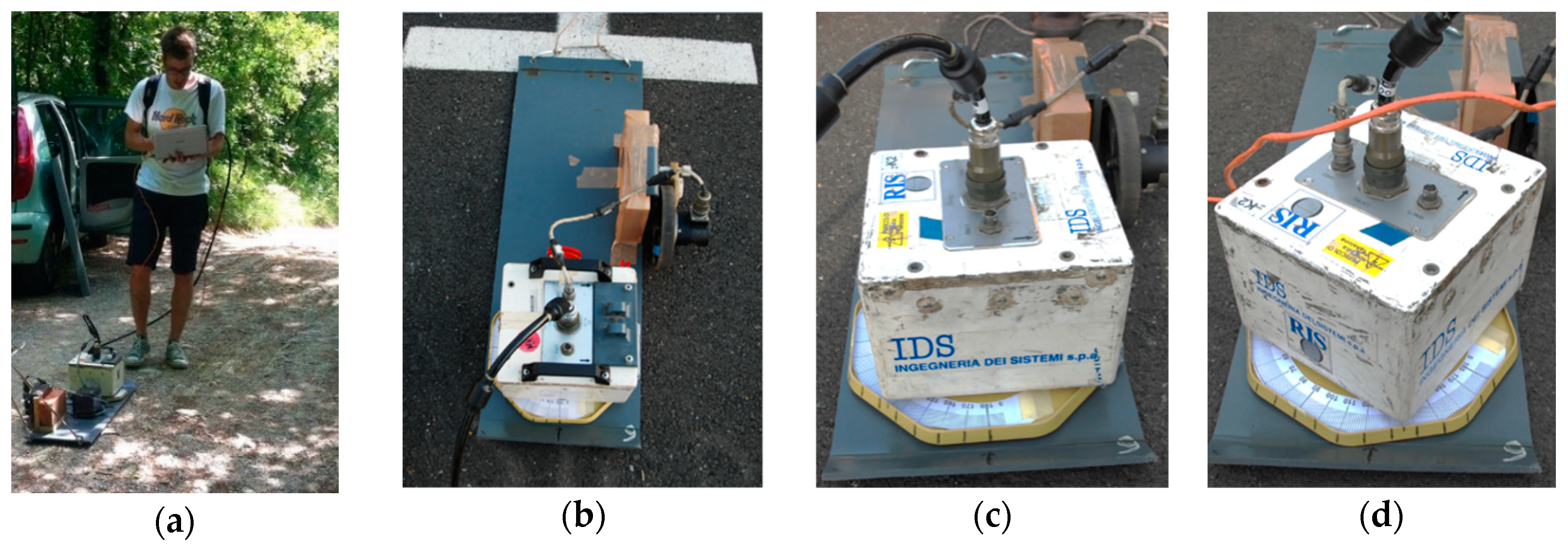


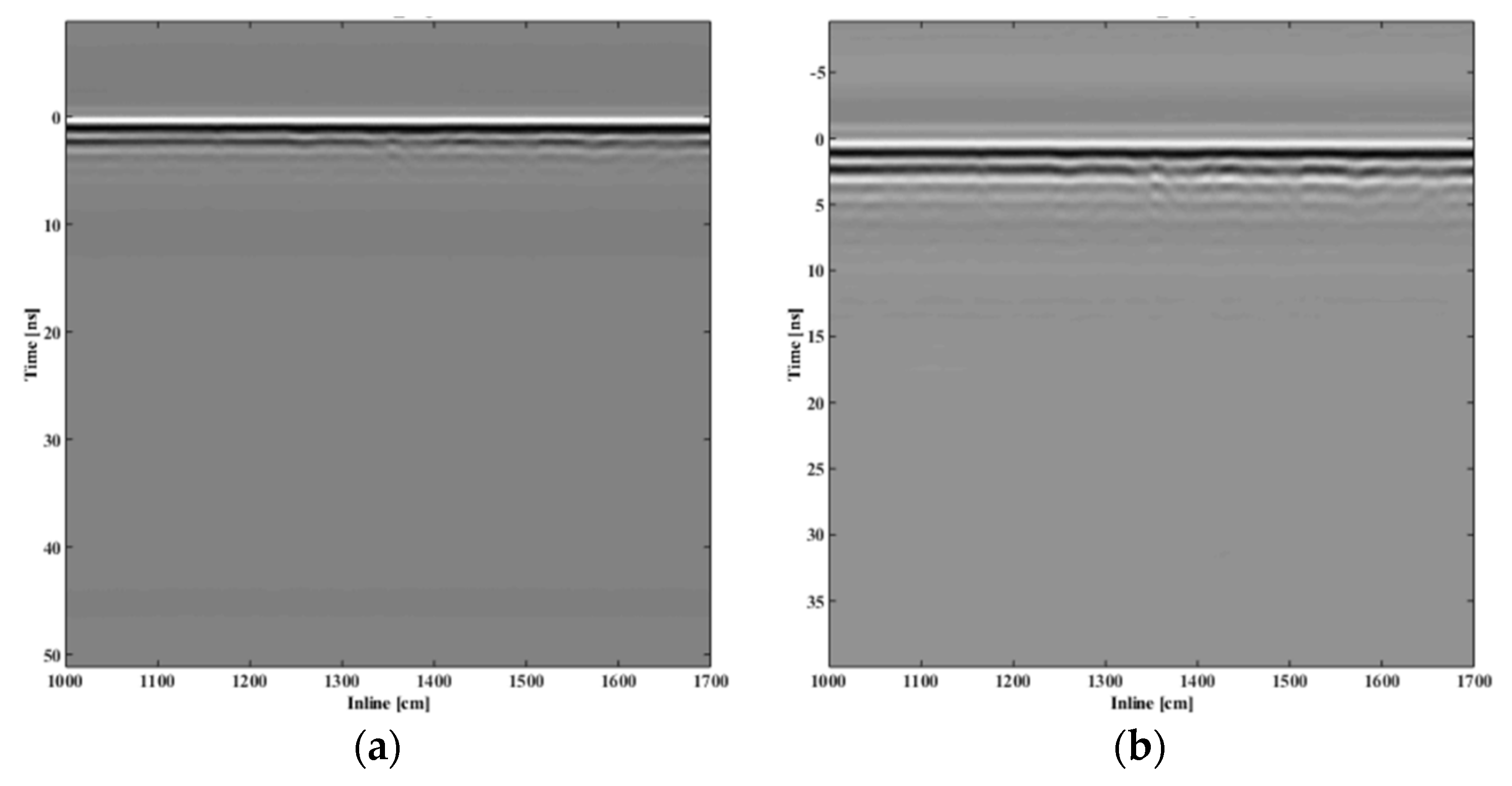
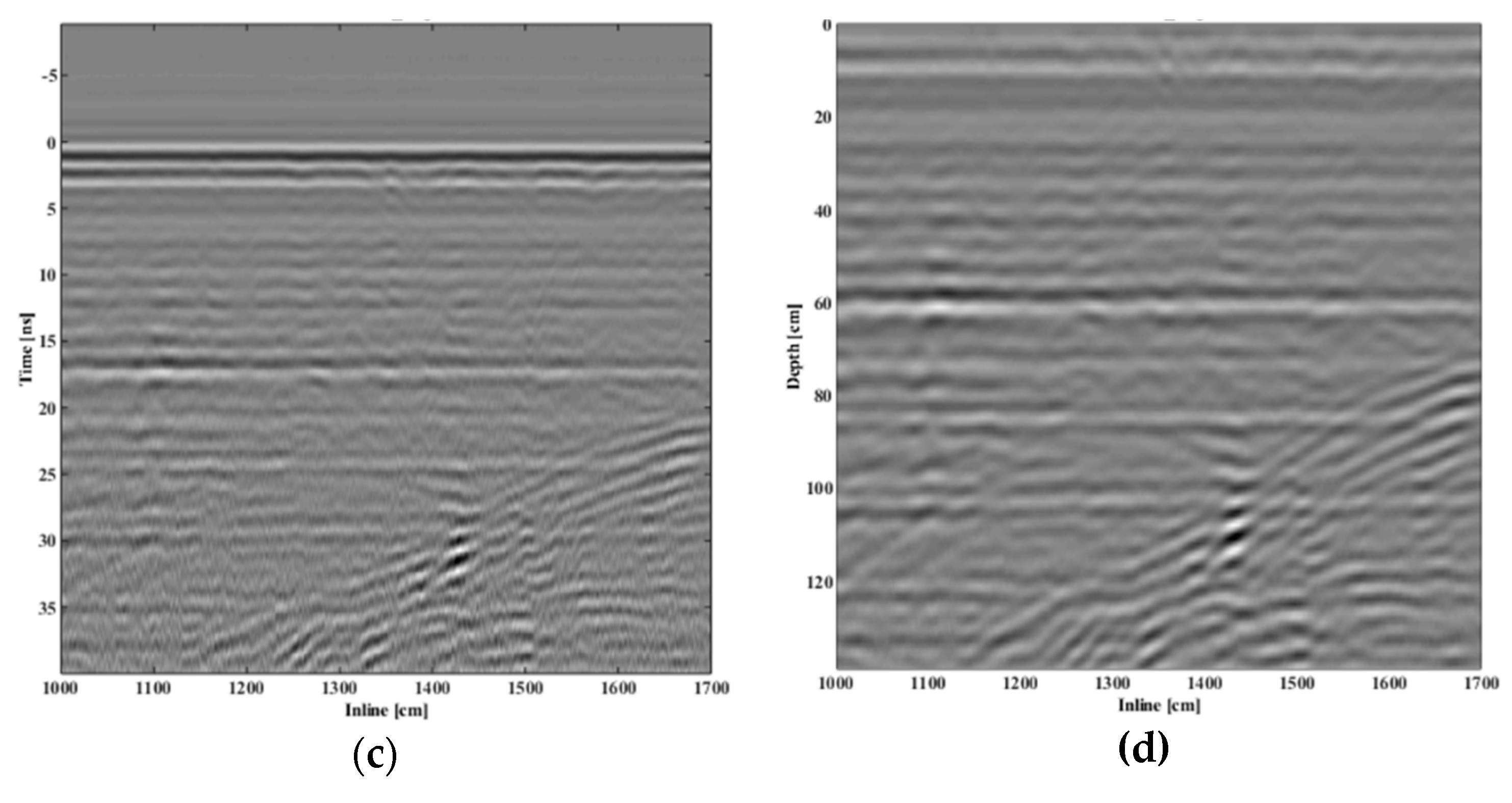
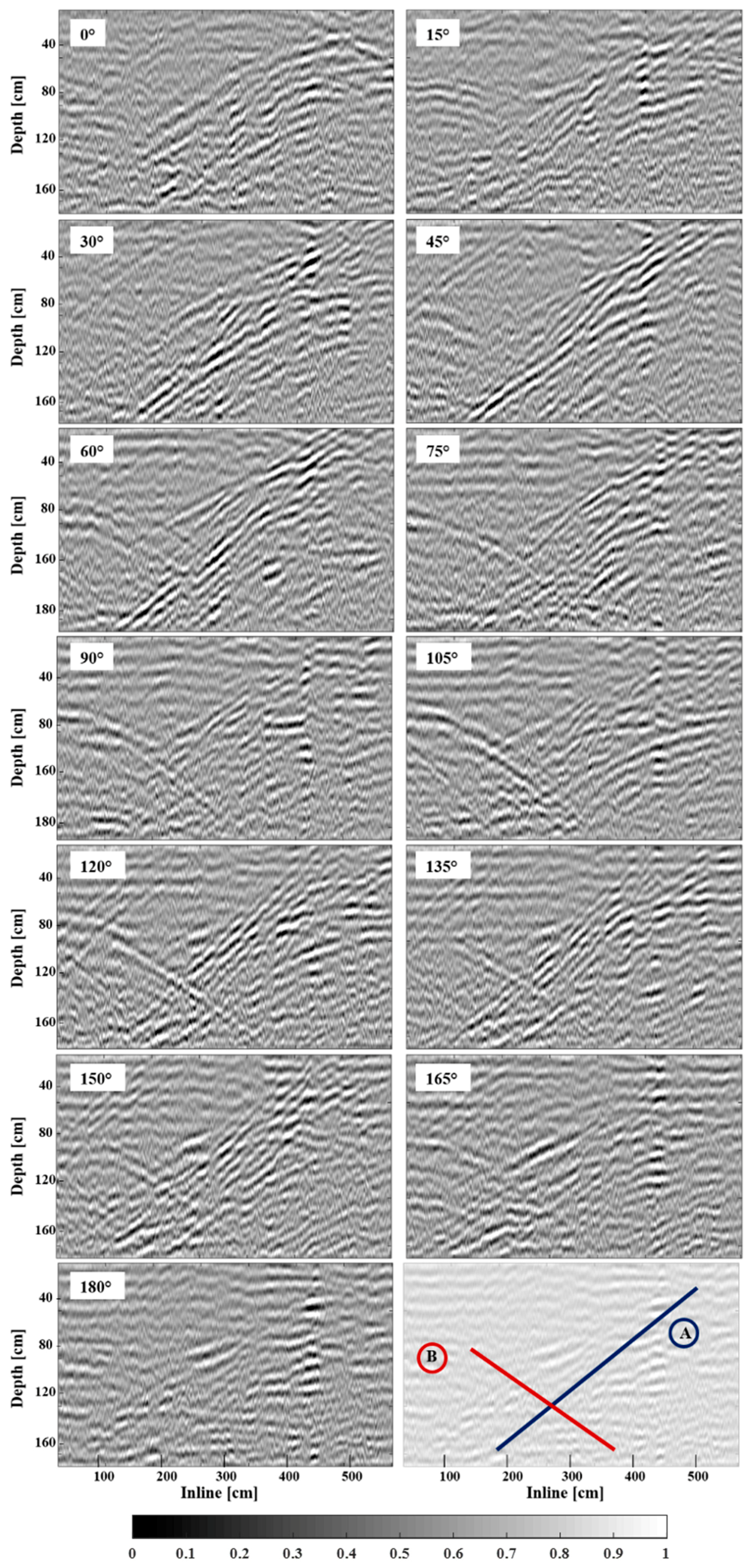
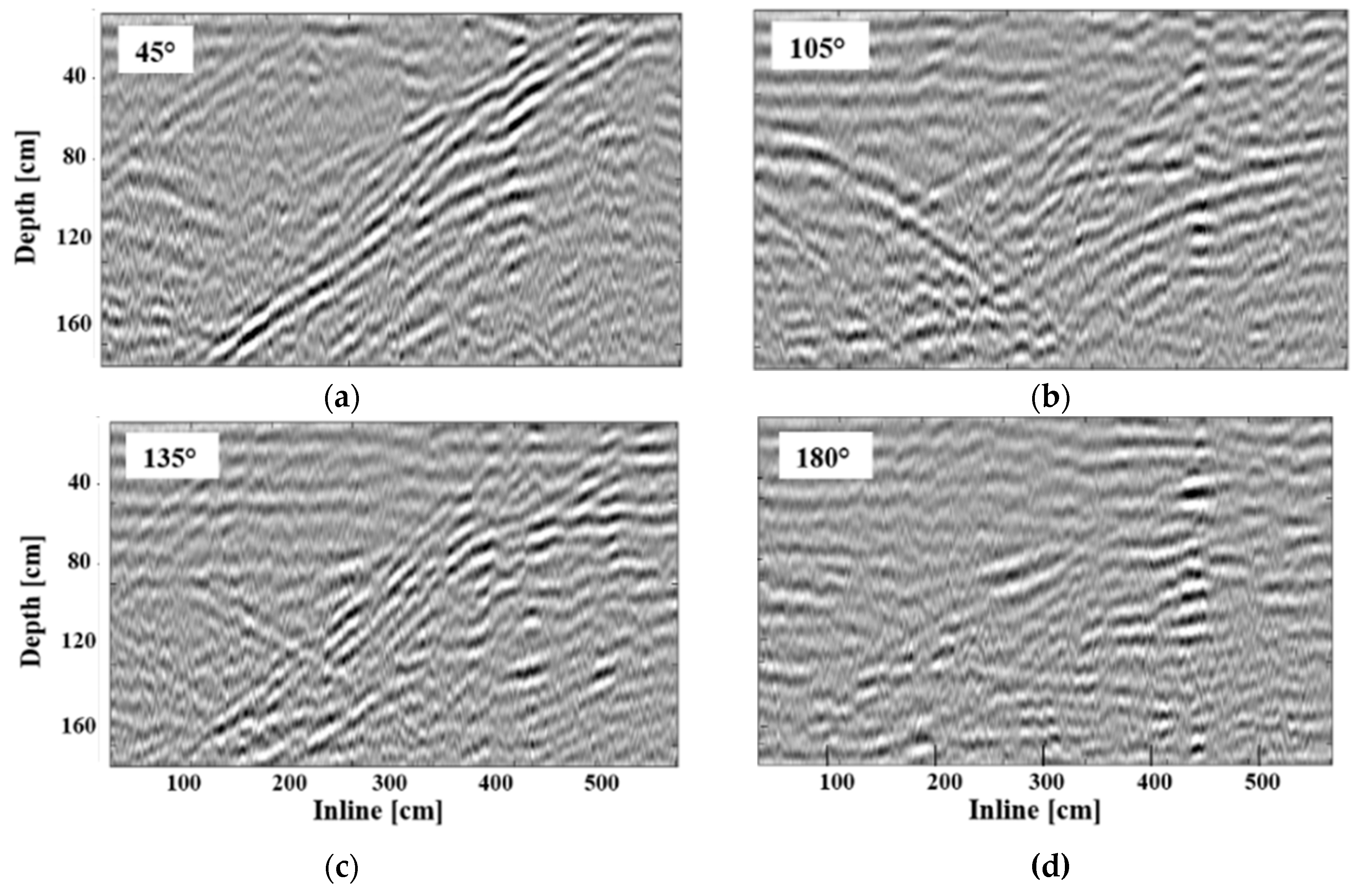
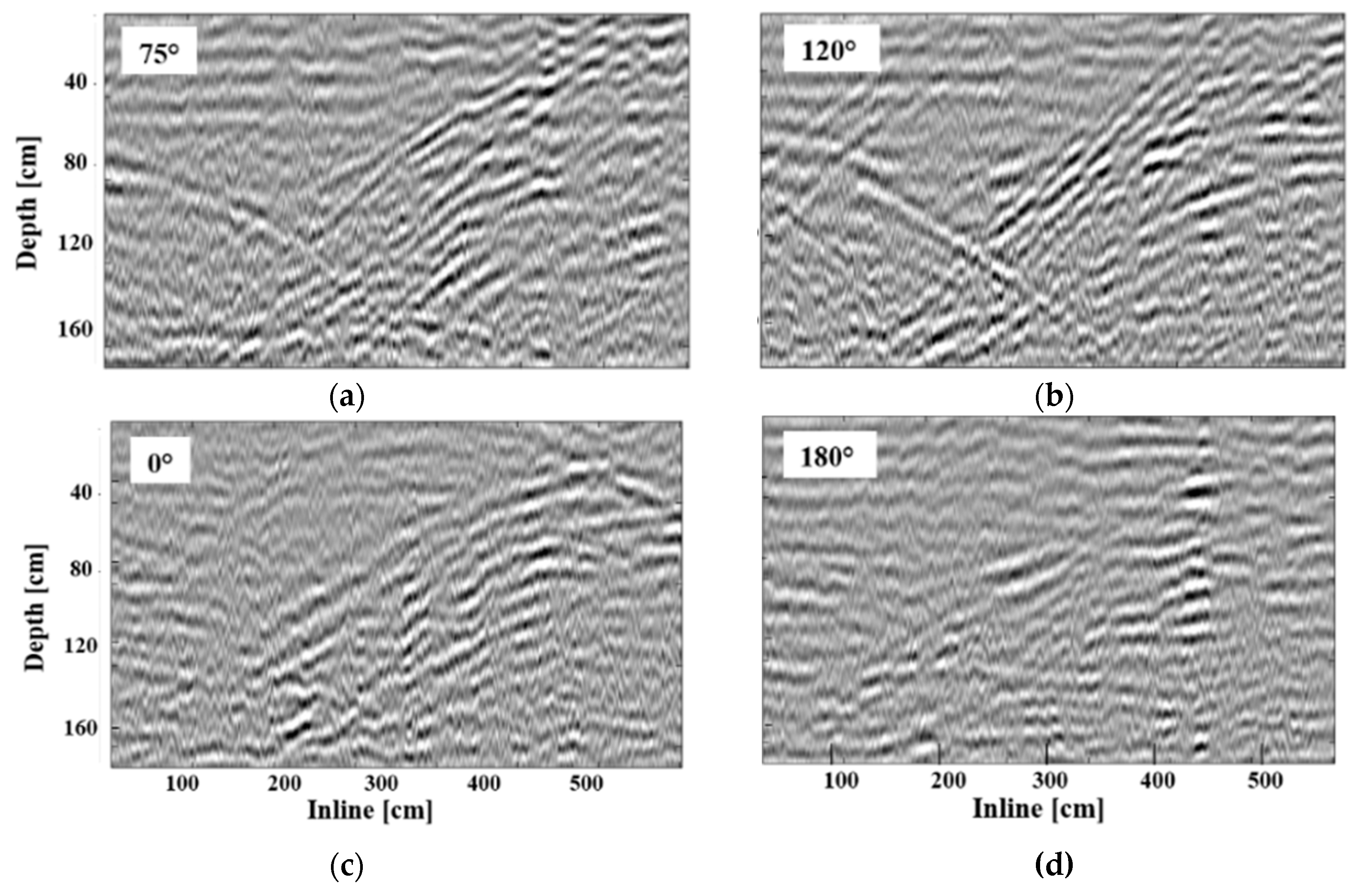

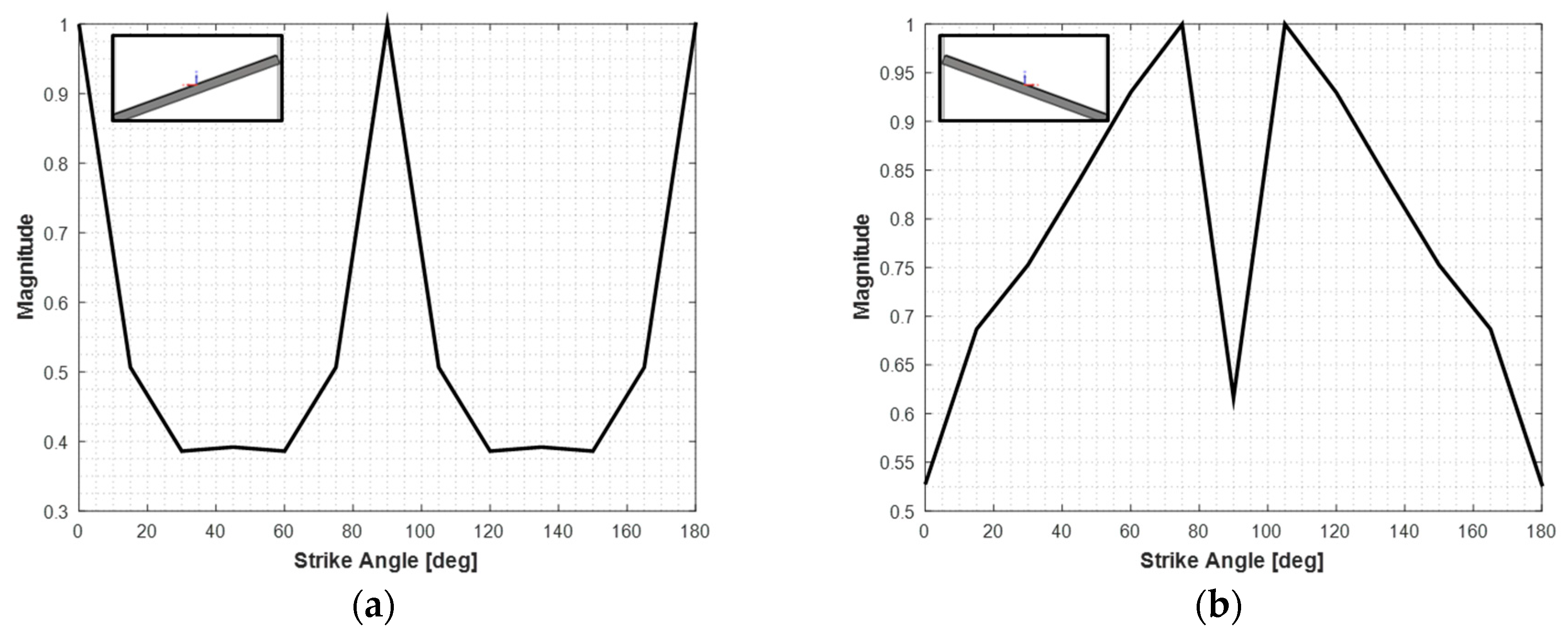
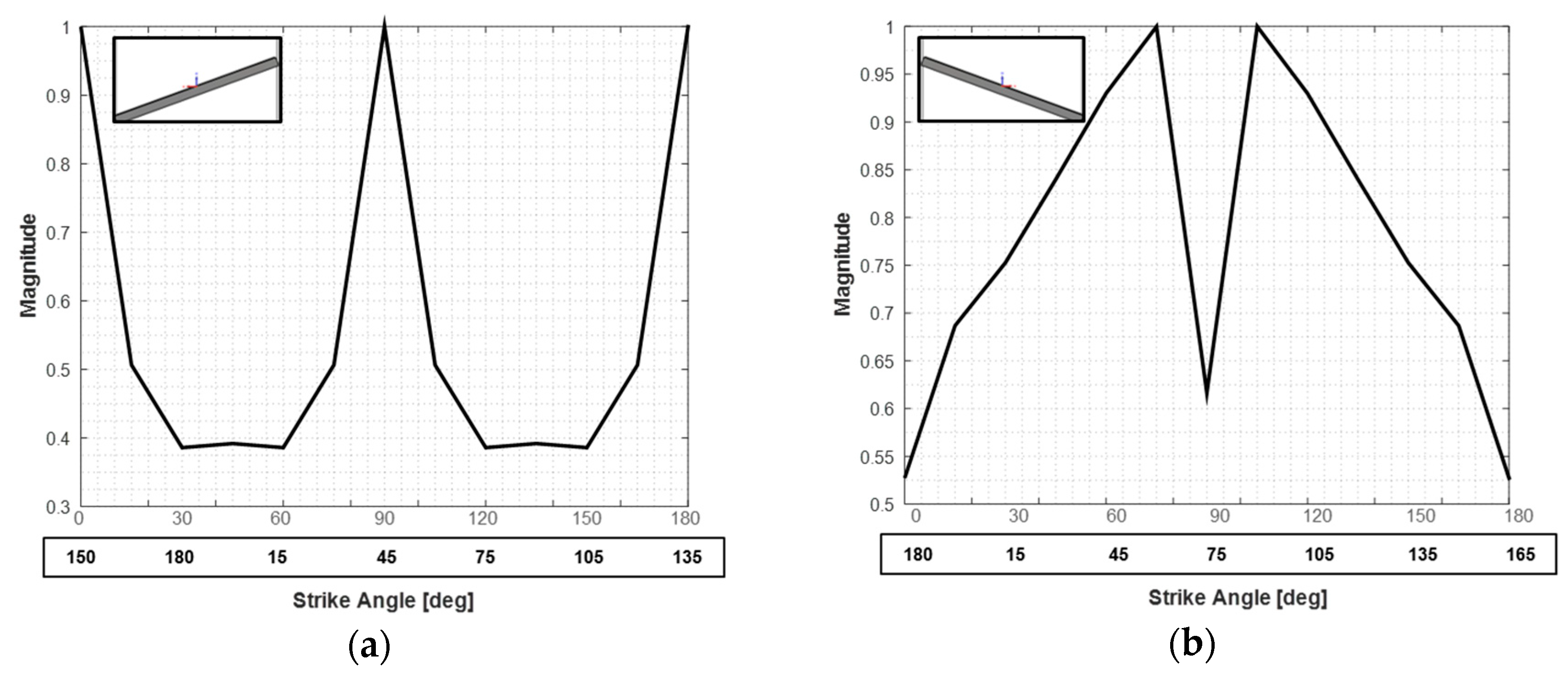
| Frequency/Bandwidth | Time Window | Time Sampling | Inline Sampling | Average Length | Angular Sampling | Number of Profiles |
|---|---|---|---|---|---|---|
| 600 MHz | 50 ns | 0.1 ns | 2 cm | 550 cm | 15 degrees | 13 |
| Frequency | Frequency Sampling | Cells per Wavelength | Plane Dip Angle | Angular Sampling |
|---|---|---|---|---|
| 300 to 900 MHz | 0.006 MHz | 10 | 20 degrees (fracture A) 160 degrees (fracture B) | 15 degrees |
© 2018 by the authors. Licensee MDPI, Basel, Switzerland. This article is an open access article distributed under the terms and conditions of the Creative Commons Attribution (CC BY) license (http://creativecommons.org/licenses/by/4.0/).
Share and Cite
Lombardi, F.; Lualdi, M. Multi-Azimuth Ground Penetrating Radar Surveys to Improve the Imaging of Complex Fractures. Geosciences 2018, 8, 425. https://doi.org/10.3390/geosciences8110425
Lombardi F, Lualdi M. Multi-Azimuth Ground Penetrating Radar Surveys to Improve the Imaging of Complex Fractures. Geosciences. 2018; 8(11):425. https://doi.org/10.3390/geosciences8110425
Chicago/Turabian StyleLombardi, Federico, and Maurizio Lualdi. 2018. "Multi-Azimuth Ground Penetrating Radar Surveys to Improve the Imaging of Complex Fractures" Geosciences 8, no. 11: 425. https://doi.org/10.3390/geosciences8110425
APA StyleLombardi, F., & Lualdi, M. (2018). Multi-Azimuth Ground Penetrating Radar Surveys to Improve the Imaging of Complex Fractures. Geosciences, 8(11), 425. https://doi.org/10.3390/geosciences8110425






